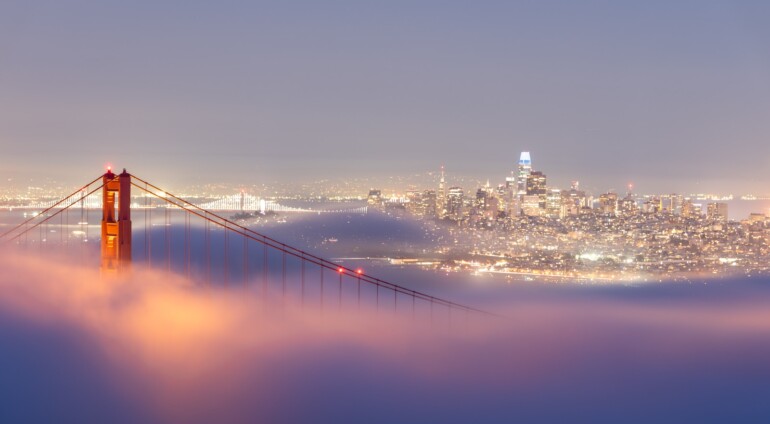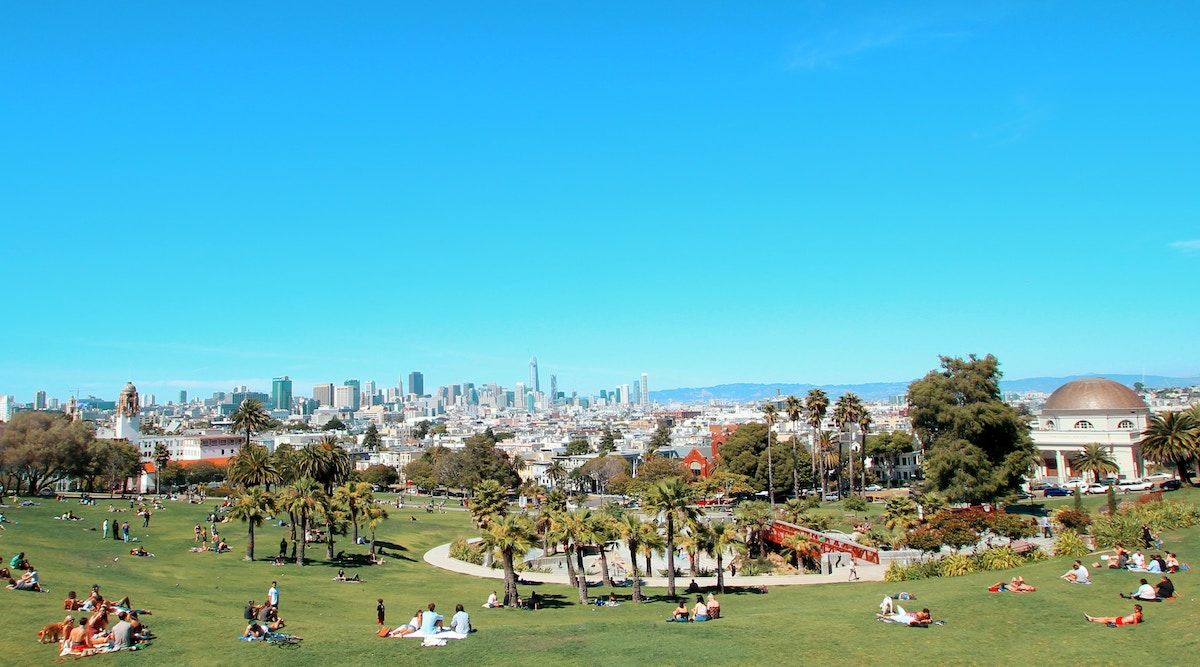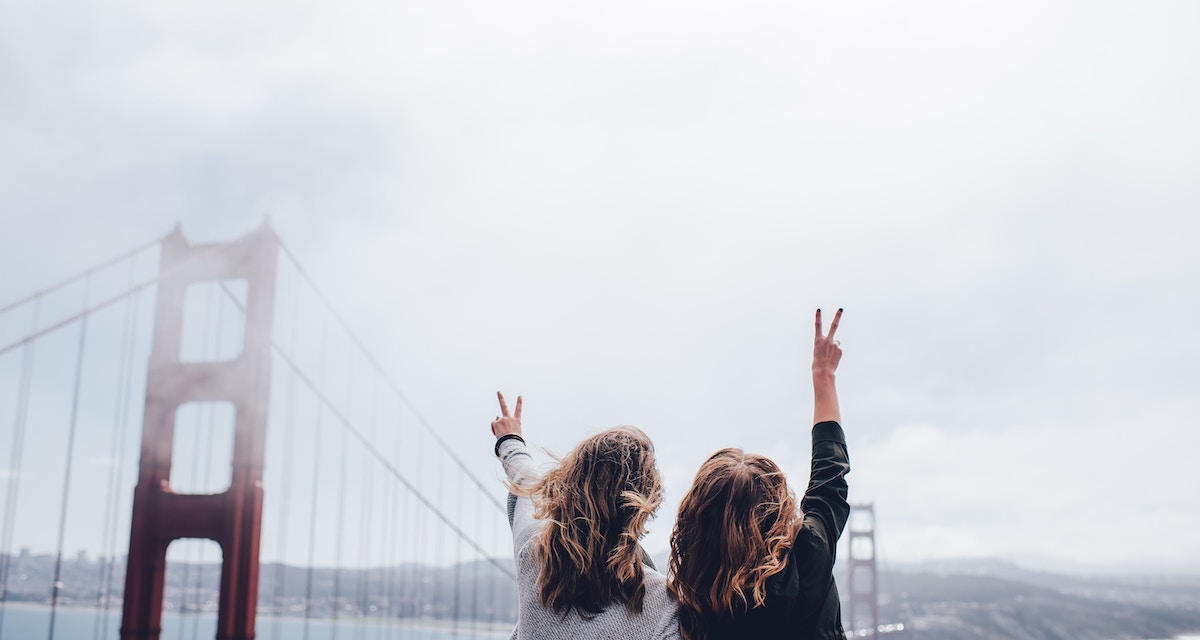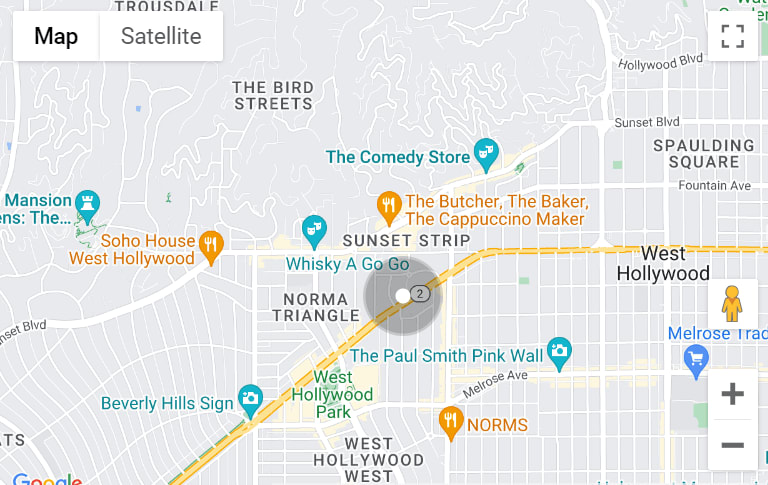Riding the Wave: Why San Franciscans are Pretty Happy With Their (Much Maligned) City

The view has not changed: gaze south from any Marin Headlands hilltop at dusk and the San Francisco skyline glimmers, with its geometric reflections shimmering in amber shades across the dark bay. The silhouette of The City is as enticing as ever — pure magic — but over the past few years, since the Covid pandemic began, the stories told about San Francisco do not match this physical beauty. The term “doom loop” has appeared in so many articles about S.F. that it has become a trope. One prominent headline last year read: How San Francisco Became a Failed City. But what if the ubiquitous doom loop narrative doesn’t tell the whole story of post-pandemic San Francisco? What if some of the common depictions of our beloved city are true but that is not the whole story?
Is it possible our favorite metropolis is still worthy of our devotion? In late 2023, that is exactly what many San Francisco residents and business owners are saying. Their experience is that many San Francisco neighborhoods are thriving, and even the downtown and Financial District, which continue to struggle with vacancies and issues surrounding poverty, are re-emerging, cleaner and more walkable than before the pandemic. San Franciscans will tell you that the negative headlines and rumors miss a broader and truer reality: there are aspects of S.F. that are as incomparable as ever, and life in some parts of the city has actually improved.
The term “doom loop” comes from the notion of the cyclical economic effects of Covid-19. Remote work meant empty offices and shuttered businesses, which resulted in a shrinking tax base and fewer social services. Fewer social services made homelessness, drug use and crime on the streets more prevalent, which led to even more people leaving the city… and so on. Anyone living or working in S.F. during the pandemic saw this urban catch-22 play out, especially downtown, with a concurrent national fentanyl epidemic reaching San Francisco’s streets and further exacerbating drug use tragedies and public fallout. And, the truth is that downtown and the Financial District have not fully rebounded; office buildings are still empty and tourism remains below the pre-pandemic levels. But according to Alex Bastian, President of the Hotel Council of San Francisco, it is also true that one dimensional storytelling about a deteriorating city is not accurate. Bastian cites a vigorous rebound over the last year and a half, with tourism gaining particular momentum in the summer and fall of 2023.
“In March of 2022 it was sad, the city was still a ghost town, dealing with smash and grabs, businesses boarded up,” says Bastian. According to Bastian, San Francisco has been in the top three in the nation in terms of hotel occupancy in major cities, but was down to 22nd place, with occupancy hovering around 25 percent in spring of 2022. “Now, in the fall of 2023, we are up to 64 percent and are ranked eighth nationally,” he says. “There is no question we are headed in the right direction and we will get back into the top three nationally.” Bastian’s optimism comes from what he describes as a newfound level of “engagement and civic pride” he sees in San Francisco. “I’ve been in the city through an earthquake and two tech bubbles,” he says, “The first steps of recovery are always the hardest. We have more work to do pushing forward on public safety, clean streets, streamlining bureaucracy, but for the first time in a long time I see San Franciscans meeting these challenges head on.”

Photo Courtesy of Unsplash
SF Travel, the San Francisco Travel Association website, confirms this rebounding trend, projecting that the number of visitors in 2023 is expected to be down just 11 percent from 2019 levels, after being down 55 percent in 2020. In August, writer Greg Sullivan, the Founder of Afar travel magazine, visited and wrote that he was “pleasantly surprised with how clean the city appeared and how the homelessness was not as widespread as we had been led to believe.” With clear political prerogative, Mayor London Breed’s administration’s recent investment in downtown is significant: the 2023-24 budget includes public safety funding for 220 new police officers over two years and $25 million to support police overtime. The government has also deployed local police officers and state and federal public safety partners to disrupt open-air drug markets, focusing on the Tenderloin and Mid-Market areas. Also included in the budget are increased security measures for parking garages and targeted regular cleaning downtown for streets and transportation hubs — the things that make a place feel cared for, even if office buildings remain vacant.
According to 27-year-old Sierra Nguyen, the Associate Director of Dolby Chadwick Gallery on Post Street near Union Square, the Civic Center area continues to feel unsafe, but her downtown neighborhood is “getting back to normal.” Nguyen lives just two blocks from the gallery, and says she feels quite comfortable moving around her neighborhood. Recently, she says, businesses like her local drug store have opened back up. “The streets feel busy again, and a lot of people are coming downtown Thursday through Sunday again, which is fun,” says Nguyen. “Of course I’m careful, the way you need to be in any city at night, but I feel safe doing my errands, going to and from work, going out.”
Nguyen’s employer, gallerist Lisa Dolby Chadwick, opened Dolby Chadwick in 1997, and has lived in San Francisco since the 1980s when she moved to the then-artsy Tenderloin. Chadwick says that while it is strange that some buildings remain unoccupied, she is also grateful for byproducts of the slowdown. “Honestly, in the years right before the pandemic, when San Francisco and tech were booming, it felt really bad. It was chaos, gridlock, traffic, the speed of everything,” she recalls. “As a gallery owner, it was terrible, you couldn’t park, you couldn’t get a dinner reservation anywhere, it was hard for clients to get to the gallery.” From Chadwick’s perspective, Union Square and the surrounding area are more live and workable than they were pre-pandemic, a return to the San Francisco she has known for decades. She trusts that business will re-emerge as they have after previous downturns. While large scale retail shops, including the Nordstroms at Westfield Mall and the Banana Republics stores at Westfield and The Embarcadero Center, have closed permanently, Chadwick believes the closures are related to the rise of online shopping as much as they are the shortcomings of the neighborhoods. “And in San Francisco, anything can happen, so you never know what will happen in those spaces,” she adds hopefully. “Maybe they will become artists’ lofts.”
While large scale retail flounders, the restaurant world is thriving, with a steady stream of new openings all over the city and foodie guides like SF Eater Restaurant Openings page are heralding new “it” spots daily. Late last year the San Francisco Treasurer and Tax Collector data showed that in the fall of 2022, almost 120 restaurants opened between late summer and early fall, which was a greater number than the same time period in 2019, pre-pandemic. On Union Square, Marin County-based celebrity chef Tyler Florence will open not one, but two new Miller and Lux Provisions cafe´s on Union Square, one a lunch and all day brunch spot, the other offering pastries. Hospitality Executive Dawn Agnew began her career at the famed Gary Danko and has worked in S.F. restaurants, hotels, bars and music venues for over two decades. Over the past few years she has had a front row seat for the downturn, and also for what she describes as a legitimate recovery. “It’s happening, and it’s happening quickly. Everybody feels it,” says Agnew. “I would say there are four neighborhoods that are buzzing right now — North Beach, NoPa (North of the Panhandle along Divisadero), Valencia Street and Chestnut.”

Photo Courtesy of Unsplash
Summer days on Pier 39, where crowds of tourists wore the requisite shorts and goosebumps in the fog, confirmed the robust tourist season, and an Instagram search of #DoloresPark shows off a new generation of young city dwellers populating the hipster enclave. According to Dr. Jennifer Brokaw, who has lived in S.F. since 2001, late summer and early fall weekends in Golden Gate Park and the Presidio have been packed with tourists and residents soaking up the dreamy late season weather. Brokaw, the Supervising Physician for the SF Fire Department, commutes from her home in Cole Valley by Muni to SoMa (South of Market). From her perspective, the city’s newfound orientation toward its most unique resource — open space — has made open spaces like Golden Gate Park even better. “What nobody can take away from S.F. is the natural beauty and access to wilderness. That is not available to us at other U.S. metropolises. When people couldn’t go to the museums and restaurants or galleries, they came to appreciate our wonderful ecosystem,” says Brokaw.
According to Brokaw, who has been swimming in the Bay at Aquatic Park and Crissy Field since 2006, her swims club’s numbers are up from between 600 and 800 pre-pandemic to somewhere in the 2000s now. “And the closure of JFK Drive to cars has exploded the number of people using Golden Gate Park,” says Brokaw. “In September, there were pianos in the botanical garden, more chairs and benches everywhere, great little coffee carts. The Tunnel Tops parks in the Presidio have been a huge success. Where I work, the SF Fire headquarters, is downtown adjacent, and what I see is that anywhere anyone has invested in outdoor spaces the payoff is huge… Mission Rock, SOMA, all the way to Dogpatch. Wherever there are parklets or slow streets, it’s booming.” One example downtown is the popular East Cut Crossing, built in March of 2023 in the Transbay neighborhood near Salesforce and Salesforce Park, a free public rec area featuring pickleball courts, street soccer fields, outdoor fitness center, a beer garden and food trucks.
The most wide-open of the city’s open spaces, Ocean Beach, and the neighborhood bordering it, have also experienced a transformation over the past three years. Of all the locales that became more popular during the pandemic, the Sunset in particular has emerged as a vibrant hotspot. “Rent in San Francisco is still expensive, but it is less expensive in the Sunset, and there’s great energy in the Sunset right now. Families and kids, a big surfing community. I’m on a group chat with around 300 people from the neighborhood,” says Jack Mangan, who is in his late twenties and moved from Oakland with his girlfriend and their puppy last year. “We have a huge block party in the fall. The French group makes crepes, that kind of thing, everyone brings their own unique offerings.” According to Mangan, he spends way too much money eating out at Hook Fish, Outerlands and DamnFine pizza, and there are now several Cheers-like bars in the Sunset (including Pitt’s Pub, Woods Outbound and Riptide). “Even if you don’t have plans on a Friday night, you can go by the bar after work. I haven’t had that experience before where I can go to a local bar and know everyone,” says Mangan.

Photo Courtesy of Unsplash
In September S.F. Supervisor Joel Engardio spearheaded the first Sunset Night Market, which was inspired by the Asian night markets he saw while visiting his husband’s family in Taiwan. The evening street festival, held in September on Irving Street between 20th and 23rd Avenues and funded by Avenue Greenlight, a local organization providing grants to community based initiatives to revitalize San Francisco neighborhoods, featured over 70 vendors, music and dance and cooking demonstrations. The inaugural night market was wildly successful, drawing thousands and confirming The City’s appetite for open air events and activities. Off the Grid, Bhangra & Beats, and Undiscovered Block Party, a recurring Filipino night market in SoMa, have had similar success. State bill, AB 441, announced in July and sponsored by assemblyman Engardio and Matt Haney, would streamline the permitting process for farmers markets and night markets. “Night markets celebrate food, music, art, and all the fun things in life,” said Engardio in a press release about the bill. “As we address the serious issues facing San Francisco, a night market reminds us why our city is worth fighting for by creating more joy. It also brings people together, makes streets safer, and helps small businesses — everything we need to create our best San Francisco.”
While that “best San Francisco” is not 100% back, San Franciscans across the city will tell you that their city is healing and that life on the ground is far from doom loop and gloom. There is an optimism on the ground which in and of itself can add to quality of life. “S.F. is a boom and bust city; it was born that way, it has always been that way,” says hospitality consultant Dawn Agnew. “There are two kinds of people in S.F.: the people who leave, and the people who stay and ride out the waves. There are a whole lot of people taking advantage of the opportunities in this city right now.”
